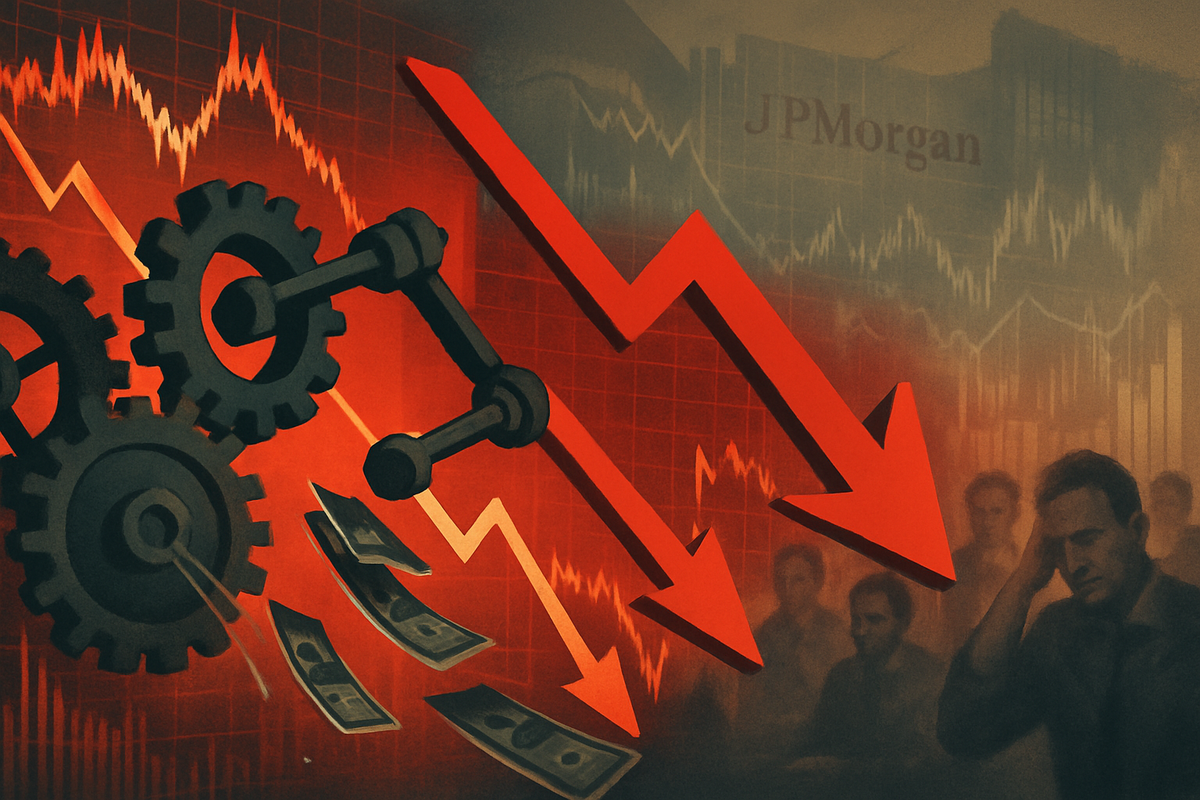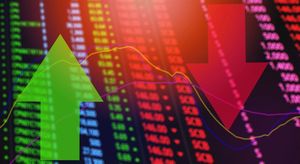
New York, NY – October 13, 2025 – JPMorgan Chase & Co. has identified a potent catalyst for rapid market downturns: levered Exchange Traded Funds (ETFs). The financial giant's analysis, which first gained significant traction following a sharp market correction in late 2024, points to the inherent structural mechanics of these amplified investment vehicles, particularly their daily rebalancing activities, as key drivers in exacerbating volatility. While the initial events that sparked JPMorgan's scrutiny occurred over a year ago, the firm's warnings resonate with renewed urgency today, as global markets grapple with persistent uncertainty and recent bouts of significant downturns.
The firm's findings underscore a critical feedback loop where market declines trigger forced selling by levered ETFs, amplifying downward pressure and contributing to a faster, more aggressive sell-off pace. This mechanism, though a known characteristic of these products, has drawn renewed attention from analysts and investors alike, especially as the popularity and asset size of levered ETFs continue to grow, posing a structural risk to market stability that JPMorgan believes cannot be ignored.
The Mechanics of a Market Accelerator: JPMorgan's Detailed Findings
JPMorgan's specific concerns crystallized around a particular market event on September 3, 2024. On this pivotal day, leveraged and inverse ETFs reportedly executed a massive sell-off of approximately $15 billion in equities. This significant rebalancing activity, described by JPMorgan as the largest selling wave from these funds since the onset of the pandemic, coincided directly with a notable 3% plunge in the Nasdaq 100 (QQQ). The firm's subsequent analysis, widely reported by September 12, 2024, laid bare the mechanics behind this market acceleration.
Leveraged ETFs are designed to deliver amplified daily returns, typically 2x or 3x the performance of their underlying index. To maintain these target leverage ratios, these funds must undergo daily rebalancing. When the market falls, their leverage ratio increases, forcing them to sell underlying assets to return to their target. This creates a cascading effect: falling prices trigger selling, which further depresses prices, leading to more selling. This feedback loop is particularly potent near market close, as rebalancing trades tend to cluster, causing rapid price swings and intensifying intraday volatility.
The influence of these funds has expanded dramatically, with leveraged and inverse ETFs collectively reaching a record $117 billion in assets during 2024. Sectors heavily concentrated with these ETFs, such as semiconductors and technology stocks, are deemed particularly susceptible to rapid shifts due to this concentrated selling pressure. Supporting JPMorgan's concerns, data from Morgan Stanley (MS) indicates that even a modest 1% drop in stock prices can now trigger nearly $7 billion in equity sales from leveraged ETFs, illustrating the scale of their potential impact.
Corporate Crossroads: Who Wins and Who Loses?
The heightened scrutiny on levered ETFs and their market impact creates a complex landscape for public companies, dividing them into potential winners and losers. Companies that issue and manage these complex products, such as ProShares (NYSE Arca: UPRO, TQQQ, etc.) and Direxion (NYSE Arca: SPXL, TECL, etc.), face a double-edged sword. While the continued popularity of these funds drives asset management fees, the increased regulatory attention and potential for market instability could lead to stricter oversight or a cooling of investor appetite, impacting their revenue streams.
On the other hand, traditional, less volatile investment vehicles and asset managers focused on long-term, diversified strategies may see a renewed appeal. Companies like Vanguard and BlackRock (NYSE: BLK), known for their broad-market index funds and actively managed ETFs that prioritize stability over amplified daily returns, could benefit from a flight to quality. Investors spooked by rapid sell-offs exacerbated by levered products might reallocate capital to more conservative options.
Furthermore, companies with strong balance sheets and less sensitivity to short-term market fluctuations, particularly in defensive sectors like consumer staples or utilities, might be perceived as safer havens during periods of increased volatility. Conversely, highly speculative growth companies, especially those in technology and semiconductor sectors that are often targeted by levered ETFs, could experience more pronounced and rapid corrections when market sentiment sours, potentially impacting their valuations and ability to raise capital. Brokerage firms that facilitate trading in these ETFs, such as Charles Schwab (NYSE: SCHW) or Interactive Brokers (NASDAQ: IBKR), might also see shifts in trading volumes depending on regulatory changes or investor sentiment towards these products.
Broader Implications: A Shifting Regulatory and Market Landscape
JPMorgan's analysis transcends a mere technical observation; it highlights a significant structural vulnerability within modern financial markets, fitting into broader industry trends concerning the proliferation of complex financial products. The increasing sophistication and accessibility of instruments like levered ETFs, particularly to retail investors, raise questions about investor protection and market stability. This event could accelerate calls for greater regulatory scrutiny from bodies like the Securities and Exchange Commission (SEC), potentially leading to new rules regarding product disclosures, suitability requirements for investors, or even limitations on their availability.
The ripple effects could extend to other market participants. Prime brokers and clearinghouses, which facilitate and guarantee trades, might face increased capital requirements or stricter risk management protocols if the perceived systemic risk from these products grows. Competitors offering alternative investment strategies, such as actively managed funds or structured products with built-in downside protection, could find new market opportunities. Historically, periods of market instability linked to specific financial instruments, like the collateralized debt obligations (CDOs) during the 2008 financial crisis or portfolio insurance in the 1987 crash, have often led to significant regulatory overhauls and shifts in investment paradigms. JPMorgan's warning serves as a stark reminder that even seemingly niche products can have outsized impacts on overall market functioning.
As of October 13, 2025, these concerns are particularly salient. On October 10, 2025, U.S. stocks experienced another sharp downturn, with the Dow Jones Industrial Average plunging 1.9%, the S&P 500 dropping 2.71%, and the Nasdaq Composite sinking 3.56%, largely attributed to renewed threats of higher tariffs on Chinese goods by President Donald Trump. Such events underscore the market's sensitivity to geopolitical developments, which could trigger further rebalancing activities in leveraged ETFs, echoing the dynamics observed in September 2024. Moreover, JPMorgan CEO Jamie Dimon's stern warning on October 8, 2025, about an impending U.S. stock market downturn, citing a confluence of global risks and elevated market valuations, further emphasizes the fragile environment in which these products operate.
What Comes Next: Navigating a Volatile Future
In the short term, investors should anticipate continued market volatility, particularly during periods of significant price movements. The structural impact of levered ETFs means that any initial market dip could be exacerbated, leading to faster and potentially deeper corrections. This necessitates a more vigilant approach to risk management and potentially a re-evaluation of portfolio allocations. Regulators are likely to maintain, if not increase, their focus on these products, with discussions around enhanced disclosures, investor education, and even potential trading restrictions becoming more prominent.
Longer term, the market may see strategic pivots. Asset managers might develop new products designed to offer similar amplified exposure but with different rebalancing mechanisms or built-in volatility dampeners. Investors, particularly retail investors, might become more educated about the risks associated with daily rebalancing and the compounding effects of levered ETFs, leading to more cautious usage. This could also spur innovation in alternative investment vehicles that provide leveraged exposure without the same daily rebalancing pitfalls. The ongoing "risk-off" rotation noted in a JPMorgan research report on October 13, 2025, highlights a broader market trend of shifting from crowded growth stocks to less crowded quality laggards, a move that could be partially influenced by the desire to mitigate exposure to instruments that amplify downturns.
Potential scenarios range from a continued, albeit more informed, use of levered ETFs with clearer understanding of their risks, to significant regulatory crackdowns that fundamentally alter their market presence. Market opportunities could emerge for platforms offering sophisticated risk analytics or for advisors specializing in navigating complex product landscapes. The challenge will be to balance market efficiency and investor access to diverse tools with the imperative of maintaining systemic stability.
Comprehensive Wrap-Up: A Call for Vigilance
JPMorgan's analysis serves as a crucial reminder of the intricate and sometimes perilous interplay between financial innovation and market stability. The September 2024 sell-off, amplified by levered ETFs, underscored a structural vulnerability that continues to warrant close attention in October 2025. Key takeaways include the significant role of daily rebalancing in exacerbating market movements, the growing asset size and influence of these products, and the potential for rapid corrections in heavily exposed sectors.
Moving forward, the market will likely remain sensitive to these dynamics. Investors must exercise heightened caution, understanding that the allure of amplified returns comes with the risk of amplified losses, particularly when market conditions turn unfavorable. The ongoing popularity of these products, despite warnings, suggests that education and transparent risk disclosure will be paramount.
What investors should watch for in the coming months includes any new regulatory guidance from the SEC or other global financial bodies, shifts in the design or marketing of leveraged products, and changes in investor behavior. The broader economic climate, including geopolitical tensions and central bank policies, will also play a critical role, as these factors can trigger the very volatility that levered ETFs are prone to amplify. Ultimately, the episode underscores the need for continuous vigilance and a deep understanding of the tools shaping our increasingly complex financial markets.
This content is intended for informational purposes only and is not financial advice





